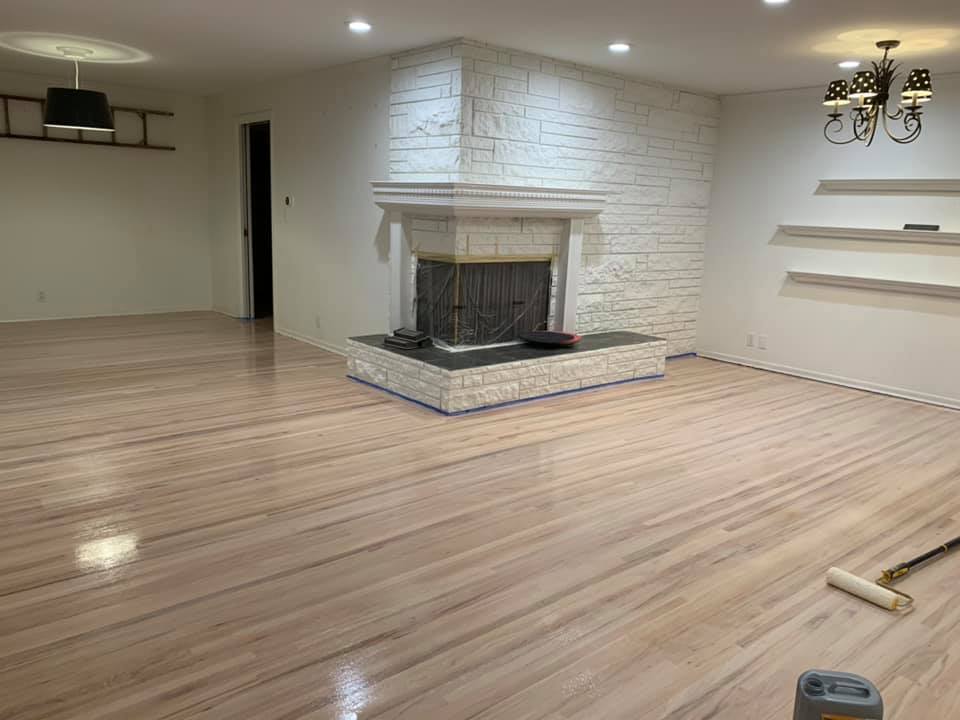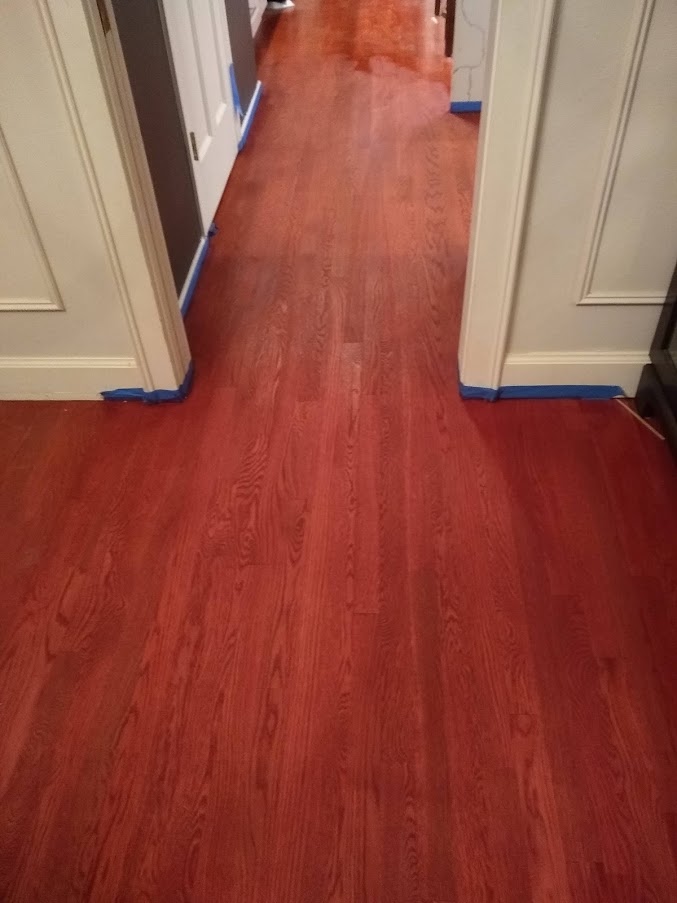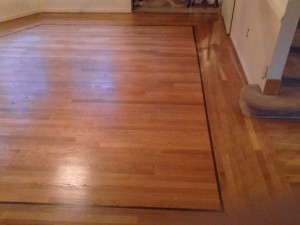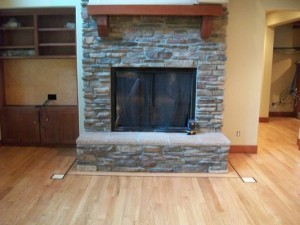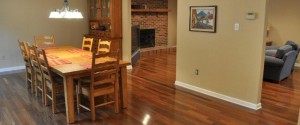A beautiful hardwood floor is just a call away!
Give us a call today for a no obligation free quote on your hardwood floor project.
Oak
There are two common types of oak flooring, red and white. back to top »
Red Oak
Red oak is white to light brown in color and very similar in general appearance to white oak, possessing a very long straight grain, and a coarse texture prior to finishing. The color of wood and grain pattern is more prominent in red oak flooring, but red oak floors are easier to clean than white, because they are more porous, making the wood more tolerant of cleaners and refinishers. back to top »
White Oak
White oak is more durable than red oak, making it a better choice for a house that is well visited. It has a similar look to red oak, being lightly colored and having a long, straight grain, which can make a room appear to be larger than it is. Overall, white oak makes the appearance of back to top »
Ash
Ash wood is extremely light to nearly white in color. This wood was formerly used to make tennis rackets and windmills due to its lightweight and sturdy nature. Floors made from ash wood are surprisingly durable given the weight of the wood, have excellent shock resistance, and remain smooth despite high traffic and friction, making the potential for damage minimal. For busy households with high levels of traffic, ash is an excellent choice. back to top »
Bamboo
One of the newest and most popular materials used in the flooring industry today. Mostly marketed in prefinished form ,Made from grass, instead of wood, bamboo is available in 1,000 species throughout the world, making it a very available and easy to find choice for floors. Bamboo flooring looks similar to a standard wood floor’s golden blond color, but is available in over 30 colors, making it versatile enough to appeal to everyone. back to top »
Beech
A white wood with a red tinge, beech is excellent for those looking to install a durable, shock resistant floor. Beech gained popularity because it is adaptable and looks great in any room with its clear, smooth appearance. The average Beech wood tree is 120 feet high with long, straight grains. The smooth grains are suitable for smaller spaces, making a room appear to be larger than it is. Beech flooring is a fantastic choice for families with pets or children, having a natural resistance to daily wear
and tear. back to top »
Birch
Yellow birch is very common for wood floors. It has a light yellow or pale appearance, and is typically chosen because of the unique curly or wavy pattern in the grain. This wood is very strong and durable, making it an excellent choice for high traffic areas or active families. back to top »
Cherry
Cherry wood comes from trees up to 200 years old, and has a creamy white color. As flooring, it is appealing because of its fine, straight grain and satiny smooth texture. Though beautiful, this wood is usually considered too soft for an entire floor or large room and is mostly used in borders and accents. Cherry wood is an excellent choice if you are looking to upgrade a room in your home by adding a medallion to your foyer or redesigning an old staircase. back to top »
Douglas Fir
Because of its tan color, douglas fir is often mistaken for southern yellow pine. This floor is considered durable but can easily dent if used in a high traffic room. This wood is recommended for rooms that do not have windows because it can fade easily with sunlight. Small bathrooms or light traffic areas are ideal places for douglas fir. back to top »
Hard Maple
Maple floors are extremely durable and available in a variety of colors and grades. Typically, the wood is creamy white with a slight reddish brown tinge and a straight grain, giving a long, linear look to a room. Hard maple polishes well making it receptive to cleaners and suitable for enamel finishes. back to top »
Hickory and Pecan
The hickories are an important wood group, and split into two groups; the true hickories, and the pecan or fruit bearing hickories. Hickory is the hardest, heaviest and strongest American wood, and is most easily recognized for its very pronounced differentiations in color. Having hickory in a room allows for freedom in accessorizing the space. You can match paints, furniture or fabrics to the various light or rich colors in the wood. back to top »
Pine
Pine is one of the softer woods. It is not as resistant to scuffs, dents and abrasions as other hardwoods, but is very often chosen for floors. Pine is better used in bedrooms, or second living rooms-spaces that get regular but not heavy traffic. Pine is light tan to yellowish white in appearance and very similar in both appearance and durability to a douglas fir floor. back to top »
Walnut
Walnut is one of the most beautiful and rich species of wood available on the market. They are famous for their blend of creamy white and dark chocolate colors and their occasional purplish tone. Walnut is a tough hardwood with a medium density, and is known for growing more lustrous with age. Cleaning walnut flooring is similar to other woods, but a refinisher like Orange Glo Hardwood Floor Refinisher can truly make this wood’s deep rich colors come to life. back to top »
Types & Styles
Solid Wood
Solid wood flooring is made of 100% wood material comes in two basic types: Solid unfinished Or solid prefinish back to top »
Engineered Wood
Engineered wood is not a natural wood species, but several layers of different woods, stacked then glued together under heat and pressure. The benefit to having engineered wood flooring in your home is that it is far less likely to be affected by changes in humidity and can be installed anywhere in your home. Engineered wood floors can be cleaned the same way as solid wood floors using non-water based cleaners. back to top »
Synthetic Plastic Laminates
Very similar to a wood laminate, plastic laminate is even more cost effective. It consists of a fiberboard that is thoroughly wrapped in layers of high-pressure laminate, a similar material to your kitchen countertop. Though cheaper, the disadvantage is that the floors wear out and cannot be sanded or refinished. The pattern of the floor repeats because laminate flooring is actually a photograph of real wood put onto a wood composite. When walking on laminates, they do not have the same sound as walking on real wood, but can be cleaned using most any cleaning products. back to top »
Grades
Grading refers to the system used by manufacturers to assess the appearance of hardwood floors. The National Wood Flooring Manufacturers Association created grades to reflect variances in color (link to color definition), grain (link to grain definition) pattern and other markings that occur in wood. The standards are meant to ensure that consumers get the best quality of wood possible. There are four standard grades your floors will be categorized into including clear (link to definition), select (link to definition), number 1 common (link to definition) and number 2 common (link to definition); however some species may have multiple grades. back to top »
Clear
A clear grade notes that wood is light in color and looks flawless. The clear grade is pure, exposes grains that run evenly and has even color throughout. The wood is free of knots, discolorations and visible markings, like a shift in the wood’s natural pattern. Upon installation, the clear grade is exceptionally durable but more expensive than other grades, and sometimes has limited availability. back to top »
Select
The select grade is given to wood that is slightly darker in color (a mix of light and medium browns), but still looks smooth and flawless. The wood may contain some natural characteristics such as small knots. It is more common than clear woods and slightly more expensive than common grades. back to top »
Number 1 Common
Common grade wood is the most frequently used in homes because it is widely available and less expensive than clear or select grades. Consumers like the medium brown color and mix of natural features like swirls in the grain or small knots. The common grade has the best overall appearance to the human eye and looks very natural throughout the entire home. back to top »
Number 2 Common
Number 2 common grade has a rustic and raw appearance with a lot of color variations, from light to dark browns. It also has visible knots and changes in the grain. This grade of wood is best used in rooms that are used for utility purposes such as laundry rooms or closets, or where character marks and a contrast in color are desired. back to top »
Utility Grade:
Has big knots and large color variation that gives a quilt like pattern to the floor. It can have worm holes and loose knots that can leave holes in the floor.
The cut of the wood determines how the pattern will look once installation is complete. Boards can be cut from a hardwood log in several directions, exposing rings in different patterns. The most popular methods of cutting include plain-sawn (link to definition), quarter-sawn (link to definition) and rift-sawn (link to definition). back to top »
Plain-Sawn
The plain-sawn cut of wood is the most common and cost effective choice when purchasing a floor. The log is cut from top to bottom, exposing the annual rings. You can actually see the tree’s growth rings in the pattern of the wood, and because this cut produces the most lumber from each log, it is the most affordable. back to top »
Quarter-sawn
The quarter-sawn method for cutting wood means the log is cut at a 90-degree angle to produce a uniform pattern in the grain. This method yields fewer and narrower boards per log than plain sawing, increasing costs significantly. Quarter-sawn boards are typically popular for decorative applications such as cabinet faces, because the grain has an even pattern. back to top »
Rift-sawn
This method of cutting is very similar in appearance to the quarter-sawn, but the wood is cut at a 30-degree or greater angle. The wood produces the least amount of boards per log, so this cut is premium and expensive. It is often favored for fine furniture and other applications where matching grain is extremely important. back to top »
Finishes
When installing hardwood floors in your home you have two options-purchase factory pre-finished planks or un-finished wood to be finished after installation. Both methods for finishing floors are widely accepted, so your choice should depend on the type of project, your budget, and the experience of your builder or installer. Having your floors finished at the time of installation can save you money. A builder often finishes a project in three steps: applying the stain, seal, and finish coat. Pre-finishing at the manufacturers can take twice as long, thus costing you more money. However, the benefit to purchasing a pre-finished floor is that the environment is controlled, eliminating factors like dust, traffic, temperature and humidity. Finishes are even and consistent due to the strict controls of manufacturers. Pre-finished hardwoods can cost as much as $1.50 per linear foot more than un-finished wood. However, there are several ways to look at the “real cost.” While pre-finished materials cost more initially, builders can save time and money during installation and do not have to be concerned about regulations for stain and finish material waste disposal. back to top »
Oil-modified urethane
This is the most common finish for your floor. This finish can come pre-finished, be applied by a professional or by you, and is available in gloss, semi-gloss, and satin sheen. The benefit in choosing an oil-based urethane finish is that it is easy to apply, usually two or three coats, and dries in up to 8 hours for each coat. This finish turns amber in color as it dries, is very durable, and must be cleaned using non-water-based cleaner such as the Orange Glo Hardwood Floor Cleaner. Floors applied with this finish can be rejuvenated with Orange Glo Hardwood Floor Refinisher. back to top »
Water-based urethane
Choosing a water-based urethane finish for your floor is an excellent choice if you are seeking a high gloss shine. It can come pre-finished, be applied by a professional or by you. When dry, this finish leaves a very light, non-yellow color and dries more quickly than oil-modified urethane. This finish is not as durable as oil-based urethane, but it is an excellent choice if you are working with a more limited budget or on a tight timeline. back to top »
Conversion Varnish [swedish]
The conversion varnish is very similar to moisture-cured urethane and is a durable finish. It dries clear and non-yellowing in about 8 hours. Though easier to apply than moisture-cured urethane, it is best left to a professional due to very strong odors. It cleans the same as most polyurethane floors-use a non-water based cleaner such as Orange Glo Hardwood Floor Cleaner and vacuum regularly. Floors applied with this finish can be rejuvenated with Orange Glo Hardwood Floor Refinisher. back to top »
Polyurethane
Polyurethane finishes are very strong and durable, and can come pre-finished, be applied by a professional or by you. The polyurethane finish is comparable to the strength of lacquer, making it a mainstream choice for very durable floors. A new trend among polyurethane finishes is adding Aluminum Oxide particles to the polyurethane finish. This increases the abrasion resistance of the wear layer. This has become an extremely popular method on the better grades of hardwood floors to increase durability. Use a non-water-based cleaner such as Orange Glo Hardwood Floor Cleaner to clean the floor and vacuum regularly. Floors applied with this finish can be rejuvenated with Orange Glo Hardwood Floor Refinisher. back to top »
UV-cured
UV-cured floors are stronger than normal polyurethane floors. Though similar to polyurethane, these floors are finished at the factory and the polyurethane finish is cured with Ultra Violet lights instead of using heat. This is a more expensive option for finishing your floors, but is recommended if you need a durable finish. back to top »
Sheen
The level of sheen you choose for your floor should be a reflection of how much shine you would like your floors to have. Certain finishes are high gloss and others have a low or satin gloss. With a high gloss floor, you’ll notice scuffs and scratches more readily than low gloss or satin finishes. High gloss finishes reflect more light and are typically used in more commercial or contemporary settings, while satin finishes reflect less light and are favored for more traditional settings, like homes and apartments. back to top »
Color
Wood colors range from light colors to the darke,r richer colors. Heartwood is the center of the tree and the oldest and most dense section of the log. It is darker and richer in color than sapwood, which lies closest to the bark. The color difference may be so pronounced that heartwood and sapwood from the same species are marketed under separate names. Each species of wood has a range of color, so you’ll be sure to find the color that is right for you. back to top »
Grain
The grain refers to the wood’s natural growth pattern, and is viewed in the wood as lines. These grains are the wood’s natural growth pattern and will affect the appearance of the wood. Depending on how the wood is cut, the grain can either be seen as a wavy or curly pattern, or more symmetrical in organized lines. back to top »
Janka Hardness Test
The Janka hardness test is a standard in the hardwood flooring industry to gauge the ability of the wood to tolerate denting and normal wear and tear. It is also a good indication of the effort required to either nail or saw the particular wood. The test is a measurement of the force necessary to embed a .444-inch steel ball to half its diameter in wood. Numbers typical range from the hundreds to the thousands, the harder the number the harder and more durable the wood. back to top »
